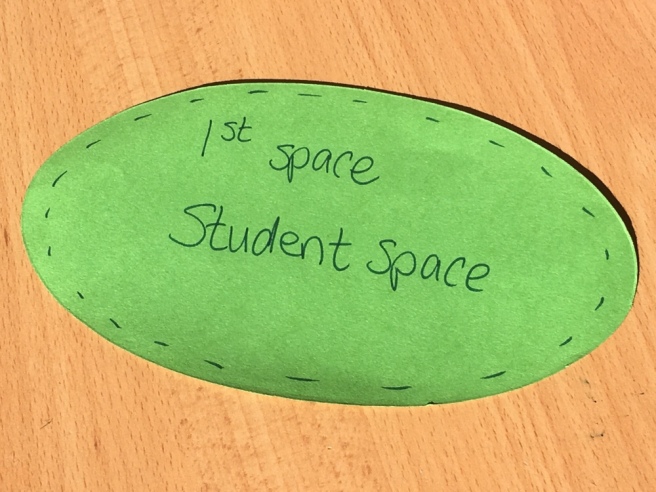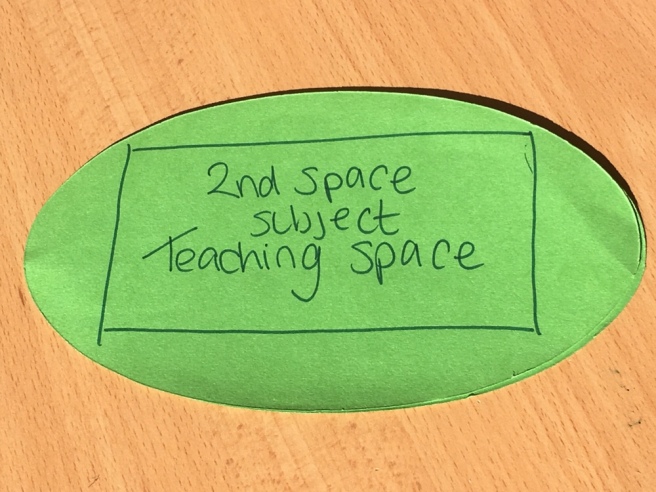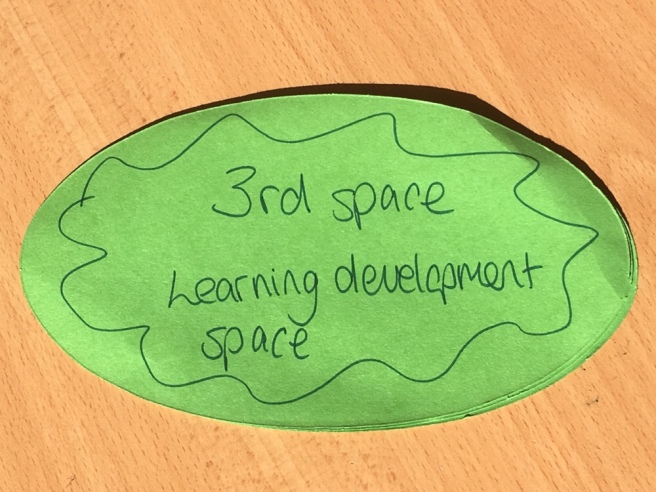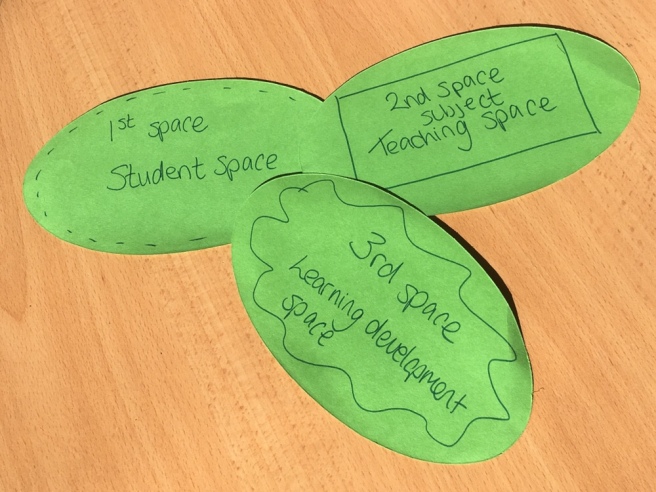I was at ALDinHE’s annual conference last week, and have been digesting all the rich, fascinating papers and conversations I encountered- material enough for several blog posts!
One session in particular jumped out at me as something I wanted to work through more in a blog post. Rosie MacLachlan, from St George’s, University of London, ran a workshop asking us to develop a conceptual model of Learning Development, unpicking all the forms it takes and trying to position them in a model. She’s run sessions like this at ALDinHE regionals, and it was a fascinating exercise not just in scoping the various ways we practice, but also in how we understand and articulate them.
Many models positioned the different forms of provision along some kind of continuum or axis associated with the curriculum, one to ones and generic sessions being outside the curriculum, and sessions embedded as part of the module, or indeed study skills modules as a whole, firmly within it. This sparked off a reflection for me – I found that I reacted quite strongly against the idea that one to one provision is outside the curriculum. I also found it interesting that we often disagreed about where to place things, or how they linked. I wondered if we were conflating conceptual spaces with physical or institutional ones – that one to one provision is thought of as outside the curriculum because it takes place outside the students’ normal classroom – the space in which the curriculum is taught, or is institutionally further away from academics, the owners of the curriculum.
On one level, there’s an obvious objection to this – due to increasing student numbers, we have central timetabling, and students are no longer taught only in their ‘home’ spaces as I was, but in whatever space is suitably sized and laid out all over the campus. To an English Literature student, would my office in the library be much different from the lecture theatre in Engineering or Medicine that’s the only one big enough on campus? Or peer mentoring or online provision that might take place in a hall of residence? The whole university campus is now curriculum space. Or is it that institutionally, learning developers are positioned differently as we’re often not on academic contracts- so the more closely we work with ‘real’ academics, the more ‘legit’ our provision is positioned as? Are we bringing students into our professional identity crisis?!
On a more conceptual level, though, I reacted against the idea of one to ones being outside the curriculum because of the nature of the conversation in one to ones. Again and again in feedback on one to ones, students mention how tailored the provision was. Which is odd, as I know nothing about chemical engineering, dentistry, architecture or business management! But if I am putting into practice the listening, coaching and mentoring roles of the Four Roles Integrated model, or applying the 5 Ps of LD to help the student examine their own learning in context, then the student brings the curriculum with them. A one-to-one can’t be outside the curriculum – it’s the curriculum’s learning outcomes, the assessment, the discipline practices which we’re examining together. My one to one practice is as embedded in the curriculum as any subject lecture. What it does stand outside of is, as I’ve discussed before, judgement – that is, formal assessment, and it offers a chance to examine the curriculum from a different perspective or angle.
So in Rosie’s session, what I started to sketch out under her facilitation was a different way to position and articulate the provision I offer. Riffing off the notion of Learning Development as a third, hybrid space, mentioned in that day’s Keynote, I tried to use ‘spaces’ in this cultural sense as a lens to position LD activity – a positioning not determined by the nature of the format itself, but by the approach or angle we’re coming from or the impetus behind it. I’ve started to look at this when I discussed learning outcomes – that they are shared three ways, between us, the student and the lecturer. This model helps me think about how the shift in balance in the three partners involved in learning outcomes might help me position my provision.
First Space
As ‘student-centred’ is one of my core values, I positioned Student Space as the First Space, decentralising the University to Second Space. Student space is porous (hence the dotted lines) – it can take in, it can expand and encompass (or reject and exclude!). I’d position good One to One provision here, I think, as the student is more in control of shaping it. It’s certainly part of the curriculum – or at least, the curriculum is part of it, as the student’s learning is of course at the heart of the curriculum.

Second Space
The Subject Teaching Space then, is Second Space. It has pretty rigidly defined boundaries and a gatekeeper – ways in are limited, and it is determined, policed and controlled by those inside. This space maps loosely onto Lave and Wenger’s community of practice, and the Academic Socialisation model. I try not to operate too much within this space unless I’m very constrained in what and how I teach! I am careful not to position myself as the gatekeeper here – I’m not the representative of the curriculum, I don’t set the boundaries, I’m the one who helps students navigate the boundaries and gates, avoid the short cuts (surface learning!) and sneaky ways in round the back (plagiarism!) but to challenge and negotiate access and residence. If I take an overly prescriptive, dogmatic, remedial approach, then I’m working (poorly) in this space.

Third Space
Third Space is of course Learning Development Space. Its boundaries are fuzzy and malleable (hence wavy lines) and it can expand or morph to accommodate the needs of the curriculum or the learner. It needs to know its boundaries, as per my post on LD as Therapy, and the increasing discomfort which LDers feel about being co-opted into a neoliberal ‘transferable skills for employability’ function. But those boundaries are accommodating and inclusive. This third space is the space I try to bring with me even when teaching at my most embedded – it’s the space I try to open up even when teaching as part of a module in a lecture theatre, in which students can explore and challenge the curriculum.

The distinction between these spaces is not their position re the curriculum – the curriculum is in all of them. Any one format, depending on how it is taught, could potentially reside in any of the spaces, though there will be a natural ideal home for each one. The distinction is, I suppose, the impetus, where the push, the power is coming from, where it starts and where it ends up, who instigates, whose perspective is dominant. In fact, what was interesting about all the models produced in the session was how they captured a sense of dynamism and movement, at the same time as trying to fix positions of different forms of provision.
Mine is still a bit half-baked as a model, but I’m very grateful to Rosie for creating this third space in which we could all think about this and begin to articulate it! I’ll continue to think about how it might be refined and applied as a way to conceptualise my learning development practice. At the moment, it’s sitting on my desk, like three amoebas, subdividing, absorbing each other, repulsing each other – dynamic. I’ll see if it evolves into a more complex life form!


Reblogged this on Becoming An Educationalist and commented:
#Becomingeducational First, Second and Third space: conceptualising learning development
We’re re-blogging this fascinating blogpost from Helen (Rattus Scholasticus) Webster on her ways of conceptualising learning development (academic mentoring etc) – and expanding the notion in within or outwith the curriculum.
How do you conceptualise or theorise your role?
Best wishes,
Sandra & Tom
Sandra just inspired me with a new thought about this. That third space – it’s effervescent. It’s a little bubble, liminal and provisional, that allows a new perspective and conversation to happen. and then it pops, but it alters the dynamic of the other two spaces. LD is fizzy! I need to do part 2!